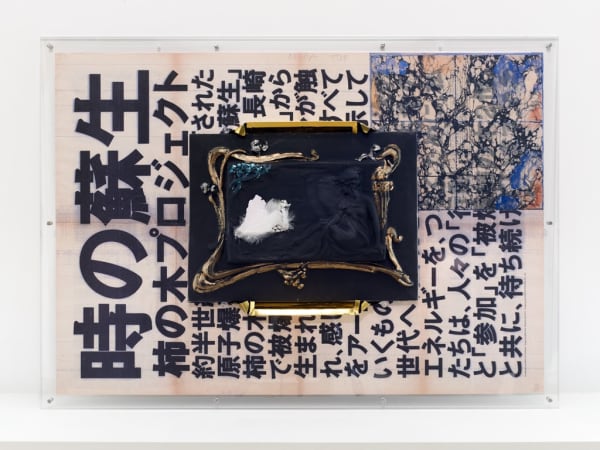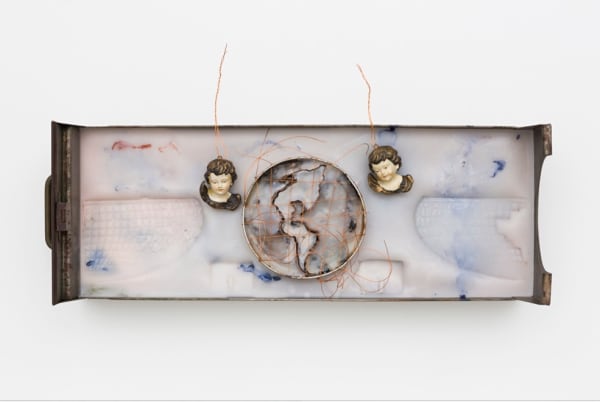Circa MMXVI New and previews works Anna Bella Geiger
I try to stablish in that show certains correspondences of an ontological order in my recent works together with some former ones. That is, although, this show includes mostly new works, they possess a syntony with other times.
For instance, when I did the two new ovals from the series Macios, panting and embroidery on canvas, I also bring works from the series of photoprints Lunar (lent by NASA), as the photoetchings from the series Local da Ação, from 1979 on. There, the planisphere with its oval shape reminds the Macios.
I think that as formal as conceptually, they reappear in the poetic of each artist that develops its own personnal shape. If this means coherence only from the formal point of view, that is not what I am talking about. There is a conjunction in which the conceptual meaning preceeds questions of a purely formal intention.
– Anna Bella Geiger
In the mid-1960s, during a period dedicated to metal engraving (etching) and tempera painting, Geiger developed a figurative style that the critic Mario Pedrosa refers to as her Visceral Phase, which raised a plethora of questions. In 1969, back in New York, she became a lecturer at Columbia University, returning to Rio in 1970. In the 1980s, she was awarded the John Simon Guggenheim Memorial Foundation Fellowship. In 1987, she co-authored Abstracionismo Geométrico e Informal: a vanguarda brasileira nos anos cinquenta with Fernando Cocchiarale, a seminal text on Brazilian 1950s art.
In the 1970s, her production became even more experimental, under the premise that the only way to create art is to be experimental. She, then shifted towards the use of other media, such as photomontage, photoengraving, photocopy, video and Super 8. With her audiovisual works of a strong political tone, Geiger assumes a singular position in the Arts, as her work goes through the modern to successfully reach the contemporary. The themes explored by her 1970s’ works, for instance, are still incredibly relevant today both in terms of her current and past production. By raising questions about what constitutes the contemporary, Geiger’s pieces bring art and critical thought closer; and by reflecting on social issues such as bureaucracy and the use of the female image, as well as an acute observation of the artistic scene, the artist has had a pioneering role in video-art.
From the 1990s to the present, Geiger has employed a variety of materials, such as in the production of Fronteiriços, folded cartographic forms in copper, placed inside iron boxes or drawers that remain isolated through the use of encaustic paint. Her poetics inhabit the margins of painting, object, engraving, sculpture, etc. Her cartographic artworks search for the efficacy of a real geopolitics and deal with issues such as the relationship between cultural and political hegemony. To examine and act upon cartographic representation is to act directly on the relations of control. Perhaps there should be a different map for a different world, and Geiger often delivers a marginal viewpoint of what the centre of the world actually means.
-
 Anna Bella Geiger, Am. Latina (Amuleto, A Mulata, A Muleta, América Latina), 1977
Anna Bella Geiger, Am. Latina (Amuleto, A Mulata, A Muleta, América Latina), 1977 -
 Anna Bella Geiger, Brasil 1500 - 1997, 1997 - 2015
Anna Bella Geiger, Brasil 1500 - 1997, 1997 - 2015 -
 Anna Bella Geiger, Brasil nativo - Brasil alienígena, 1976-1977
Anna Bella Geiger, Brasil nativo - Brasil alienígena, 1976-1977 -
 Anna Bella Geiger, CAMOUFLAGE, 1980
Anna Bella Geiger, CAMOUFLAGE, 1980 -
 Anna Bella Geiger, Circumambulatio, 1972
Anna Bella Geiger, Circumambulatio, 1972 -
 Anna Bella Geiger, Corpo feminino e seu appendix (após Brecheret), da série Transferrs, 2014
Anna Bella Geiger, Corpo feminino e seu appendix (após Brecheret), da série Transferrs, 2014 -
 Anna Bella Geiger, EW18 com a teoria do Black Hole e pés descalços, from the series Macios, 2018
Anna Bella Geiger, EW18 com a teoria do Black Hole e pés descalços, from the series Macios, 2018 -
 Anna Bella Geiger, LEDA e o CISNE n.1, 2018
Anna Bella Geiger, LEDA e o CISNE n.1, 2018 -
 Anna Bella Geiger, OHREN ATHENA COM ORBIS DESCRIPTIO, from the series Fronteiriços, 2017
Anna Bella Geiger, OHREN ATHENA COM ORBIS DESCRIPTIO, from the series Fronteiriços, 2017 -
 Anna Bella Geiger, Orbis Descriptio com Américas e dois ventos, 1999
Anna Bella Geiger, Orbis Descriptio com Américas e dois ventos, 1999 -
 Anna Bella Geiger, Orbis Descriptio com Mapa Mundi e as 3 Graças, from the series Fronteiriços, 2018
Anna Bella Geiger, Orbis Descriptio com Mapa Mundi e as 3 Graças, from the series Fronteiriços, 2018 -
 Anna Bella Geiger, Passagens I, 1974
Anna Bella Geiger, Passagens I, 1974 -
 Anna Bella Geiger, Passagens II, 1974
Anna Bella Geiger, Passagens II, 1974















